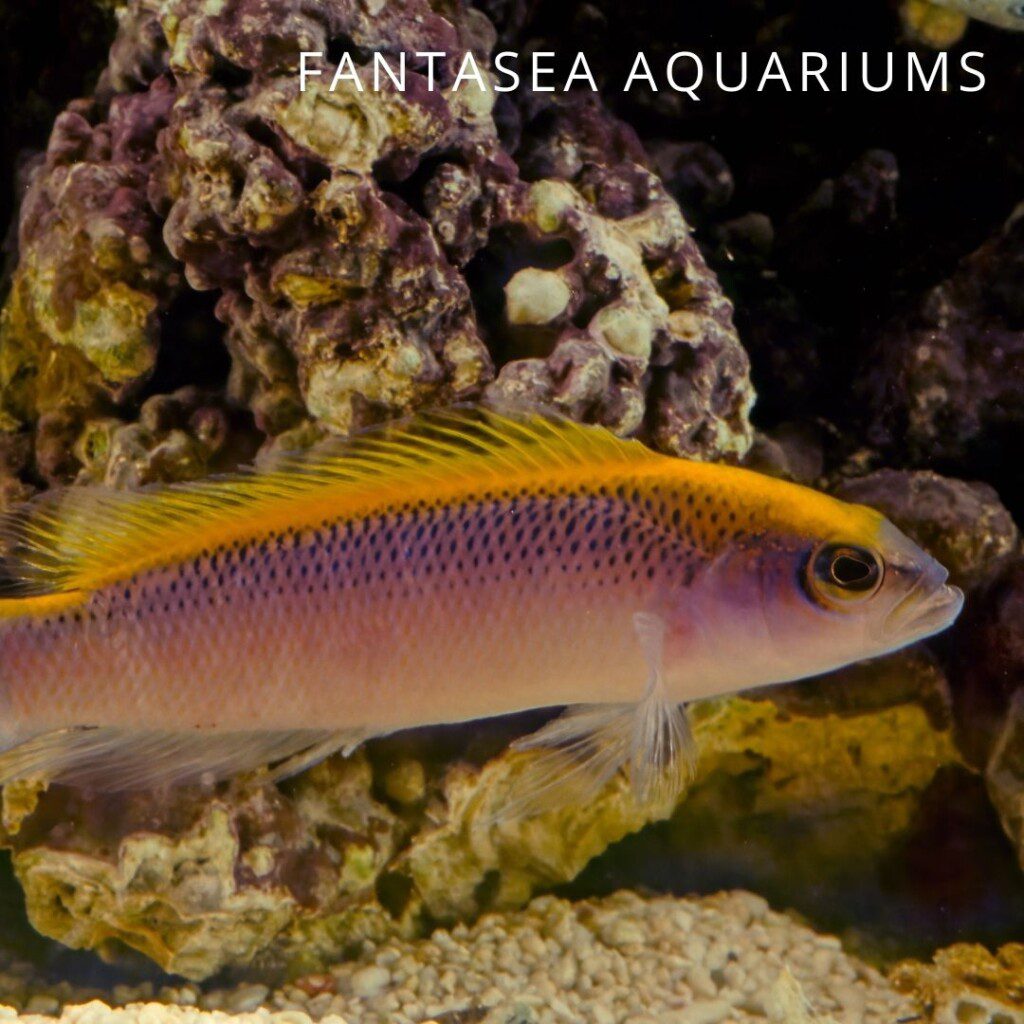We’ve seen the sunrise dottyback referred to as the ‘gem of the Red Sea’ and we’re inclined to agree! If you’re looking for a colorful, jewel-toned fish to add to your marine aquarium and aren’t afraid of going for a somewhat territorial species, this might just be the ideal choice for your tank.
Keep reading for everything you need to know about the sunrise dottyback and keeping this Pseudochromis in your home aquarium!
| Name (Common, Scientific) | Sunrise dottyback, Pseudochromis flavivertex |
| Minimum tank size | 20 gallons |
| Minimum group size | 1 |
| Temperature | 75-82 °F |
| Salinity | 1.020-1.025 |
| pH | 8.1-8.4 |
| Difficulty level | Easy |
Sunrise dottyback (Pseudochromis flavivertex) description
The sunrise dottyback was named for the fact that its coloration is reminiscent of a sunrise over the sea. Its body is blue, with a bright yellow stripe at the top that runs all the way from the head to the tip of the tail. Quite dramatic!
The species is naturally found in shallow waters in the western Indian Ocean and grows to a maximum size of only around 3”. Unfortunately, it’s not possible to visually tell the difference between a male and female sunrise dottyback.
Sunrise dottyback (Pseudochromis flavivertex) aquarium
If you’d like to keep a sunrise dottyback, it’s best to go for an aquarium of at least 20-30 gallons. Make sure it has a lid, as like many aquarium fish, these guys are prone to jumping when startled.
Make sure the tank is fully cycled before introducing any fish and include plenty of hiding places in the form of live rock and other décor. Although it’s not overly shy and skittish, the species does appreciate access to caves and crevices to retreat to and scour for tasty morsels.
Sunrise dottyback (Pseudochromis flavivertex) compatibility
The compatibility section in a care guide is what you want to have a look at when it comes to dottybacks! Although the sunrise dottyback is by no means among the most aggressive of its genus (the neon dottyback is worse, for example), that doesn’t mean it always plays nice either.
Although sunrise dottybacks are considered more or less reef safe, they are carnivores that naturally feed on all sorts of small critters they find scuttling among the rocks. This is problematic if you keep small invertebrates like shrimp, which can easily fall prey to a hungry dottyback. It can be an advantage if you’re dealing with annoying pests like bristleworms, though.
As for fish tankmates, it’s important to avoid large and assertive species if you want to see the relatively docile sunrise dottyback on a regular basis. Instead, you could consider small but quick species like grammas or dwarf angelfish; introduce the dottyback last if you’re worried about territorial squabbles.
We generally recommend against keeping multiple dottybacks in the same aquarium, even less aggressive species like this one. It may work if you have a large enough tank, but in order to keep the peace, it’s usually best to just go for one.
The exception would be if you buy two sunrise dottybacks of different sizes and introduce them at the same time. This should usually result in the larger fish turning into a male – they’re protogynous hermaphrodites – and the two pairing up. Still, be sure to have a plan B in case things don’t work out.
Sunrise dottyback (Pseudochromis flavivertex) diet
Sunrise dottybacks are not known to be difficult eaters in captivity. Most are captive bred nowadays and should be used to commercial fish foods like frozen mysis and brine shrimp. Even pellets and flakes will usually be accepted without issue. Remember: a high-quality, varied diet will make for a more brightly colored fish!
You can feed your sunrise dottyback once or twice a day.
Conclusion
A beautiful aquarium filled with colorful fish like the sunrise dottyback is a joy to see. But even though this species is suitable for beginners, that doesn’t mean everyone’s got the time and expertise to maintain a marine aquarium!
If you’re still in need of an eye-catcher for your home or office but don’t want to design, set up and maintain your own fish tank, you can contact FantaSEA here so we can help out.











